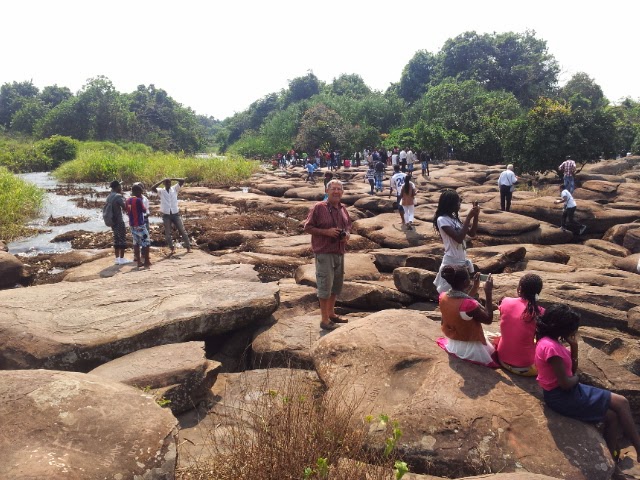D38 (2013.07.13, Fazenda Gemac - Kalandula Waterfall - Pedras Negras, 212 km)
Each time we left a fazenda where we had overnighted, I felt a twinge of another move into the unknown - perhaps we can stay another night?? But then the unknown also draws me like a magnet. Goodbye to Fazenda Gemac!Wherever we travelled, small villages line the road side. This group happily posed for a photo showing how they pounded maize.
The symmetry of this plantation and the bright green grass fascinated me.
This road used to be tarred - the strips can be clearly seen but it's not easy to drive on them.
If you're heading to Kalandula Waterfall, you need to know that the sign shows the way to the Miradoura (concrete look-out). Turn left!!! Guide books refer to Cachoeiras de Kalandula.
Our car guard - if English is a problem, then sign language works! The waterfall is a very popular outing for locals. In fact, many buses offloaded visitors, not to mention all the private cars that were parked near the falls.
The "miradoura" is opposite a derelict hotel (which has a magnificent view of the falls).
We moved to the top of the falls where the river Lucala passes underneath the rocks before it plummets down the falls. At 400m wide and 105m high, these falls are rated as second/third highest in Africa (Bradt, 2011:246). Many people inscribed their names on the softish rocks.
We enjoyed the break from our travels. Then we headed south again across the bridge over the Lucala river, eventually taking the right-hand split in the road towards Cacuso and Pedras Negras.
A group of villagers were congregated around the communal water point.
A veld fire raging at a safe distance.
Upgrading the road
A church at Cacuso (?)
Our first glimpse of Pedras Negras (the black rocks of Pundo Andongo) and the entrance into the area.
A close up of the texture of the rocks - sedimentary conglomorate (de lux), not found anywhere else in the area!! This raises the question: Where do these massive rocks come from?
This footprint could be those of Queen Ginga (1582-1663) who hid herself when surprised by soldiers while she was bathing (Bradt, 2011:249) but they could also be the footprint of an eminent politician (?) who quite recently was involved in upgrading the area.
The Pedras Negras road that lead to a small settlement where we bought some vegetables from the ladies who were watering their plot.
Our camping spot - we felt as if we had landed in heaven!
D39 (2013.07.14, Pedras Negras, 0 km)
A day of housekeeping and rest.

































No comments:
Post a Comment